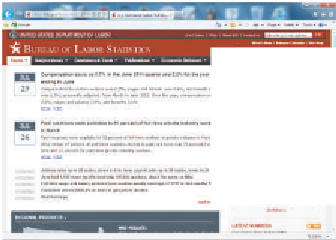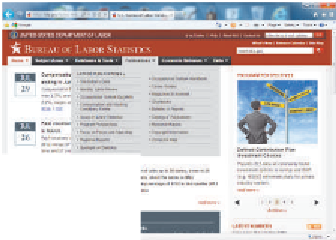HTML and CSS Reference
In-Depth Information
multimedia and consists of a collection of linked documents. To support multimedia, the
Web relies on the
Hypertext Transfer Protocol
(
HTTP
), which is a set of rules for
exchanging text, graphic, sound, video, and other multimedia files. The linked documents,
or pages of information, on the Web are known as
Web pages
. Because the Web supports
text, graphics, sound, and video, a Web page can include any of these multimedia
elements. The Web is ever-changing and consists of billions of Web pages. Because of the
ease of creating Web pages, more are being added all the time.
A
Web site
is a related collection of Web pages that is created and maintained by
an individual, company, educational institution, or other organization. For example, as
shown in Figure 1-3, many organizations, such as the U.S. Department of Labor, publish
and maintain Web sites. Each Web site contains a
home page
, which is the first document
users see when they access the Web site. The home page often serves as an index or table
of contents to other documents and files displayed on the site.
Internet and WWW
History
The World Wide Web
Consortium (W3C or
w3.org), the de facto
organization that
governs HTML, provides
a particularly rich history
of the Internet and the
World Wide Web. Search
on “Internet history”
or “WWW history” in
your browser for many
additional sources.
Figure 1-3 A Web site is a related collection of Web pages that is created and maintained by
an individual, company, educational institution, or other organization.
Web Servers
Web pages are stored on a
Web server
, or
host
, which is a computer that stores
and sends (serves) requested Web pages and other files. Any computer that has Web server
software installed and is connected to the Internet can act as a Web server. Every Web
site is stored on, and runs from, one or more Web servers. A large Web site may be spread
over several servers in different geographic locations.
In order to make the Web pages that you have developed available to your audience,
you have to publish those pages.
Publishing
is copying the Web pages and associated
files such as graphics and audio to a Web server. Once a Web page is published, anyone
who has access to the Internet can view it, regardless of where the Web server is located.
For example, although the U.S. Department of Labor Web site is stored on a Web server
somewhere in the United States, it is available for viewing by anyone in the world. Once
a Web page is published, it can be read by almost any computer: whether you use the
Mac, Windows, or Linux operating system, with a variety of computer hardware, you have
access to billions of published Web pages.




















































































































































































































































